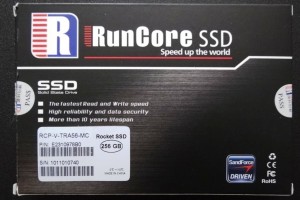PACKAGING AND COMPONENTS
Exterior packaging for the Runcore Rocket Air was that of a cardboard exterior with foam multi-layer insert. It described the capacity as being 256GB, although the SSD was LSI SandForce Driven, spoke of performance up to 540MB/s which was a tad higher than listed specs, and provided a product ID of RCP-V-TRA56-MC.
Inside was a very attractive aluminum external casing and USB 3 cable which, not only allowed for a very effective plug and play migration of the MBA but also, it could later become a very effective means of external storage with the old SSD installed.
The Runcore Rocket Air 256GB SSD contains the LSI SandForce SF-2281 Flash Storage Processor (FSP) along with eight modules of Toshiba 24nm Toggle Mode NAND flash memory, each with a capacity of 32GB. To give you an idea of the company this specific memory keeps, you might want to check out our previous reviews on the SMART Storage XCeedStor 500S enterprise SSD, SMART Storage Optimus SAS, orthe Corsair Neutron GTX to name just a few.
BENCHMARK SOFTWARE
The software we will be using for today’s analysis is typical of many of our reviews and consists of ATTO Disk Benchmark, Crystal DiskMark, AS SSD, Anvil Storage Utilities and PCMark Vantage. We rely on these as they each have a way of supporting one another yet, at the same time, adding a new performance benchmark to the total picture. Much of the software is free and can be downloaded simply by clicking on the linked title.
SSD COMPRESSION AND TESTING FLUCTUATIONS
All SSDs are not created equal and many new SSD enthusiasts realize that when they test their new drive to confirm specifications and ensure all is in order. SandForce controlled SSDs, as in the Runcore Rocket Air SSD we are testing today, use compression techniques in storage whereas many others do not. This creates a bit of confusion when enthusiasts test the drive with random data through benchmarking programs such as AS SSD and Crystal DiskMark. The results seem to be lower than the listed specifications.
The results actually present a false portrayal of the drives ability when compared to other drives such as Samsung, Crucial or Intel. It is for this reason that all of our comparison testing is done through PCMark Vantage. PCMark Vantage HDD Suite simply provides evaluation results based on transfer speeds reached through typical user patterns. Vantage provides a better testing medium, in that, it sees through the typical synthetic benchmarks and provides us with ‘true to life’ results of the drive.
 The SSD Review The Worlds Dedicated SSD Education and Review Resource |
The SSD Review The Worlds Dedicated SSD Education and Review Resource | 


It seems like many of us are on our second or third mSATA SSD and using a mSATA-to-2.5inch converter inside a 2.5inch enclosure is a waste of space. Have you seen a USB3-to-mSATA enclosure that is just as sleek as that aluminum external adapter?
No I don’t know of any other than Mac specific ones as we have seen from Runcore and OWC, both being blade style specific and not mSATA. MyDigitalSSD markets one we did a short piece on but it is an external that is the size of a SSD
Hi, where I can buy this SSD?
It is still to be released in typical outlets and I might contact Runcore.
Not sure if you still have the drive, but if so, any chance you might be able to examine battery life as compared to the stock SSD? One of the critiques of the Aura was that it had a higher power draw than the stock SSD. Thanks! 🙂
Negative sorry.
Will it fit the new imac 27′?
and will we have the possibility to make fusion drive with it?
Any update on this blade SSD compatibility with Asus zenbook and prime series laptops and also on its poor performance issue not meeting the manufacture’s published data?
Will it work with X1 Carbon model 2012/2013